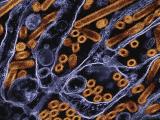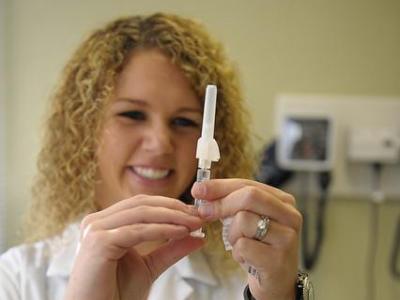Jan 14, 2008 (CIDRAP News) – A research report published last week says that the factors governing whether H5N1 avian influenza viruses can invade human cells are more complex than previously thought and have to do with the particular shape of the cell-surface sugar molecules to which viruses attach.
The conventional wisdom has been that avian flu viruses, including H5N1, prefer to attach to receptor molecules known as alpha 2-3 glycans, whereas human flu viruses, such as H1N1 and H3N2, prefer to bind to receptors called alpha 2-6. The terms refer to the nature of the link between sialic acid, which forms the tip of the receptor molecule, and galactose, an adjoining sugar unit.
Alpha 2-6 glycans are said to be abundant in the human upper respiratory tract. The accepted view has been that a change in the H5N1 virus's binding preference from alpha 2-3 to alpha 2-6 would be a key step toward its transformation into a human pandemic strain.
But the new study, published in Nature Biotechnology, suggests that the difference in binding preference between human and avian flu viruses is more complicated than just alpha 2-6 versus alpha 2-3. Rather, it is an affinity for a particular topology, or shape, of alpha 2-6 glycan receptor that characterizes human flu viruses, says the report, written by a team from the Massachusetts Institute of Technology (MIT) and the Centers for Disease Control and Prevention.
Why shape matters
Specifically, the researchers report that human flu viruses prefer long alpha 2-6 receptors that occupy an umbrella-shaped space, as opposed to those, including alpha 2-3 and some alpha 2-6 receptors, that occupy a cone-shaped space.
"The efficient human adaptation of these viruses is . . . correlated with HA binding to sialylated glycans of a characteristic umbrella-like topology, going beyond the specific alpha 2-3 or alpha 2-6 linkage," write the researchers, led by Aarthi Chandrasekaran of MIT. They say their findings will improve scientists' ability to monitor the evolution of human adaptation of avian flu viruses.
The authors used a combination of several techniques to gather and interpret their data. First, they used a staining technique and mass spectrometry on sections of human tracheal epithelial tissue to examine the distribution of alpha 2-6 glycans in the tissues. The results showed that these receptors were predominant in the upper respiratory tract lining and that they showed "substantial diversity" in length and composition.
Data gathered from the first analysis were then used to determine the "conformational features" of the alpha 2-3 and alpha 2-6 glycans. The analysis led to the conclusion that alpha 2-3 and short alpha 2-6 receptors occupy a cone-shaped space, whereas the umbrella shape is unique to alpha 2-6 glycans and is typically assumed by longer versions of these molecules.
Further, in part by using existing data on the structure of hemagglutinin (HA) in different flu viruses—the viral surface protein that links up with host cell receptors—the authors determined that the HAs in human flu viruses "have mutated from their presumed avian counterparts to gain additional contacts with alpha 2-6 in the umbrella-like topology."
The researchers sought further evidence in the extensive existing data from studies of glycan arrays, in which many different glycans are laid out on slides and then exposed to HAs from different flu viruses to see which ones bind to which glycans. Seeking correlations between the features of different glycans and the various HAs, the authors found more evidence that H5N1 HAs prefer to bind to alpha 2-3 and short alpha 2-6 glycans but not to long alpha 2-6 glycans.
Finally, the scientists treated preserved sections of human tracheobronchial tissue with different concentrations of HAs from H1 and H3 human flu viruses and observed the resulting binding patterns. This work further demonstrated the "high-affinity binding" between these HAs and the long alpha 2-6 glycans. The researchers also found that two H5N1 viruses, used in high concentrations, showed some affinity for alpha 2-6 gylcans, but this was minimal compared with their affinity for alpha 2-3 glycans.
"Taken together, the above findings show that the human-adapted HAs bind specifically to the long alpha 2-6 [glycans] (in the umbrella-like topology), which are predominantly expressed in the human upper respiratory tract," the researchers state.
They write that other flu virus genes may play a role in H5N1 transmission, but that mutations permitting the virus to bind to long alpha 2-6 receptors will be a necessary condition for it to fully adapt to humans.
The authors recommend the use of glycan arrays containing long alpha 2-6 units to monitor the evolution and human adaptation of influenza A viruses. They call for the development of arrays to permit rapid dose-dependent analyses of HA binding patterns.
Caveats cited
Dr. John Nicholls, an associate professor in the pathology department of Hong Kong University who has done research on how human and avian flu viruses bind to host cells, said the study sheds important light on how avian viruses may adapt to humans, but he also added some caveats.
"This study was what was needed to put together what type of sialic acids the influenza viruses bind to and what was really available for binding within the respiratory tract," Nicholls told CIDRAP News via e-mail. "As a note of caution, the analysis of what glycans are present in the respiratory tract has been done on cells grown in culture . . . and the question arises to what extent these represent normal human adult and paediatric trachea and bronchi, so clearly we need to move from this in vitro model to the in vivo setting."
He added that efficient human-to-human transmission of viruses may depend on viral replication not only in the bronchi, but also in the nasopharynx. Studies of H5N1-infected patients in Vietnam have shown that replication does occur in the nasopharynx, he said.
In addition, Nicholls said, "It is not just binding that is a requirement for human adaptation (and more importantly what determines human to human transmission), but also, as the authors mention, factors such as neuraminidase and other viral gene products." For example, studies by Kawaoka and colleagues have shown that changes in the PB2 gene allow the virus to replicate at different temperatures in the respiratory tract.
"However," Nicholls concluded, "the importance of this article is that it does shed more light on the finer details of this first step in viral adaptation to humans—binding. Importantly, the simple alpha 2-3 versus alpha 2-6 paradigm as a determinant of host specificity of influenza viruses appears to be a great over-simplification."
Chandrasekaran A, Srinivasan A, Raman R, et al. Glycan topology determines human adaptation of avian H5N1 virus hemagglutinin. Nature Biotech 2008 (advance online publication) [Abstract]


















